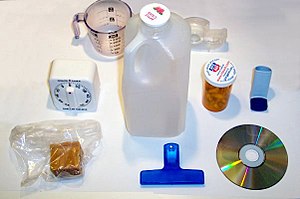
Back Plastiek Afrikaans Kunststoff ALS Plastico AN لدائن Arabic پلاستيك ARY প্লাষ্টিক Assamese Plásticu AST Plastmas Azerbaijani پیلاستیک AZB Пластмассалар Bashkir

Plastics are a wide range of synthetic or semi-synthetic materials that use polymers as a main ingredient. Their plasticity makes it possible for plastics to be molded, extruded or pressed into solid objects of various shapes. This adaptability, plus a wide range of other properties, such as being lightweight, durable, flexible, and inexpensive to produce, has led to their widespread use. Plastics typically are made through human industrial systems. Most modern plastics are derived from fossil fuel-based chemicals like natural gas or petroleum; however, recent industrial methods use variants made from renewable materials, such as corn or cotton derivatives.[1]
Between 1950 and 2017 9.2 billion metric tons of plastic are estimated to have been made; more than half of this has been produced since 2004. In 2020, 400 million tons of plastic were produced.[2] If global trends on plastic demand continue, it is estimated that annual global plastic production will reach over 1.1 billion tons by 2050.
The success and dominance of plastics starting in the early 20th century has caused widespread environmental problems,[3] due to their slow decomposition rate in natural ecosystems. Most plastic produced has not been reused, or is incapable of reuse, either being captured in landfills or persisting in the environment as plastic pollution and microplastics. Plastic pollution can be found in all the world's major water bodies, for example, creating garbage patches in all of the world's oceans and contaminating terrestrial ecosystems. Of all the plastic discarded so far, some 14% has been incinerated and less than 10% has been recycled.[2]
In developed economies, about a third of plastic is used in packaging and roughly the same in buildings in applications such as piping, plumbing or vinyl siding.[4] Other uses include automobiles (up to 20% plastic[4]), furniture, and toys.[4] In the developing world, the applications of plastic may differ; 42% of India's consumption is used in packaging.[4] In the medical field, polymer implants and other medical devices are derived at least partially from plastic. Worldwide, about 50 kg of plastic is produced annually per person, with production doubling every ten years.
The world's first fully synthetic plastic was Bakelite, invented in New York in 1907, by Leo Baekeland,[5] who coined the term "plastics".[6] Dozens of different types of plastics are produced today, such as polyethylene, which is widely used in product packaging, and polyvinyl chloride (PVC), used in construction and pipes because of its strength and durability. Many chemists have contributed to the materials science of plastics, including Nobel laureate Hermann Staudinger, who has been called "the father of polymer chemistry," and Herman Mark, known as "the father of polymer physics".[7]
- ^ "Life Cycle of a Plastic Product". Americanchemistry.com. Archived from the original on March 17, 2010. Retrieved July 1, 2011.
- ^ a b Environment, U. N. (October 21, 2021). "Drowning in Plastics – Marine Litter and Plastic Waste Vital Graphics". UNEP - UN Environment Programme. Retrieved March 21, 2022.
- ^ "The environmental impacts of plastics and micro-plastics use, waste and pollution: EU and national measures" (PDF). europarl.europa.eu. October 2020.
- ^ a b c d Cite error: The named reference
Applicationswas invoked but never defined (see the help page). - ^ American Chemical Society National Historic Chemical Landmarks. "Bakelite: The World's First Synthetic Plastic". Retrieved February 23, 2015.
- ^ Edgar D, Edgar R (2009). Fantastic Recycled Plastic: 30 Clever Creations to Spark Your Imagination. Sterling Publishing Company, Inc. ISBN 978-1-60059-342-0 – via Google Books.
- ^ Teegarden DM (2004). Polymer Chemistry: Introduction to an Indispensable Science. NSTA Press. ISBN 978-0-87355-221-9 – via Google Books.